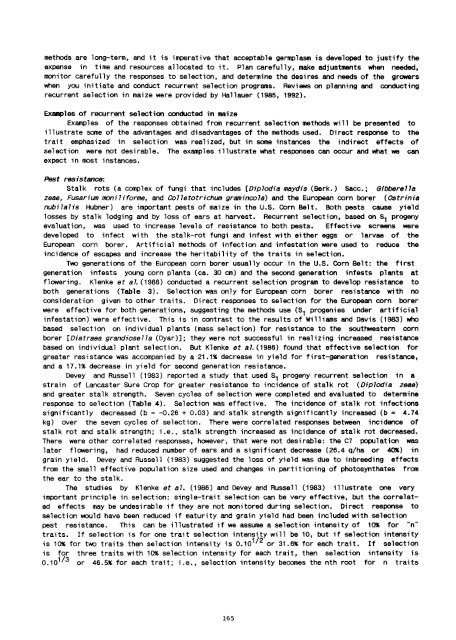Proceedings of the Fifth Asian Regional Maize Workshop - Search ...
Proceedings of the Fifth Asian Regional Maize Workshop - Search ...
Proceedings of the Fifth Asian Regional Maize Workshop - Search ...
You also want an ePaper? Increase the reach of your titles
YUMPU automatically turns print PDFs into web optimized ePapers that Google loves.
methods are long-term, and it is imperative that acceptable germplasm is developed to justify <strong>the</strong><br />
expense in time and resources allocated to it. Plan carefully, make adjustments when needed,<br />
monitor carefully <strong>the</strong> responses to selection, and determine <strong>the</strong> desires and needs <strong>of</strong> <strong>the</strong> growers<br />
when you initiate and conduct recurrent selection programs. Reviews on planning and conducting<br />
recurrent selection in maize were provided by Hallauer (1985, 1992).<br />
Examples <strong>of</strong> recurrent selection COl'lOOcted in maize<br />
Examples <strong>of</strong> <strong>the</strong> responses obtained from recurrent selection methods will be presented to<br />
illustrate some <strong>of</strong> <strong>the</strong> advantages and disadvantages <strong>of</strong> <strong>the</strong> methods used. Direct response to <strong>the</strong><br />
trait emphasized in selection was realized, but in some instances <strong>the</strong> indirect effects <strong>of</strong><br />
selection were not desi rable. The examples illustrate what responses can occur and what we can<br />
expect in most instances.<br />
Pest resistance:<br />
Stalk rots (a complex <strong>of</strong> fungi that includes [Dip1odia maydis (Berk.) sacc.; Gibbere11a<br />
zeae, Fusarium moni1iforme, and Co11etotrichum grsminco1a) and <strong>the</strong> European corn borer (OStrinia<br />
nubi1a1is Hubner) are important pests <strong>of</strong> maize in <strong>the</strong> U.S. COrn Belt. Both pests cause yield<br />
losses by stalk lodging and by loss <strong>of</strong> ears at harvest. Recurrent selection, based on S1 progeny<br />
evaluation, was used to increase levels <strong>of</strong> resistance to both pests. Effective screens were<br />
developed to infect with <strong>the</strong> stalk-rot fungi and infest with ei<strong>the</strong>r eggs or larvae <strong>of</strong> <strong>the</strong><br />
European corn borer. Artificial methods <strong>of</strong> infection and infestation were used to reduce <strong>the</strong><br />
incidence <strong>of</strong> escapes and increase <strong>the</strong> heritability <strong>of</strong> <strong>the</strong> traits in selection.<br />
Two generations <strong>of</strong> <strong>the</strong> European corn borer usually occur in <strong>the</strong> U.S. COrn Belt: <strong>the</strong> first<br />
generation infests young corn plants (ca. 30 em) and <strong>the</strong> second generation infests plants at<br />
flowering. Klenke et a~ (1986) conducted a recurrent selection program to develop resistance to<br />
both generations (Table 3). Selection was only for European corn borer resistance with no<br />
consideration given to o<strong>the</strong>r traits. Direct responses to selection for <strong>the</strong> European corn borer<br />
were effective for both generations, suggesting <strong>the</strong> methods use (S1 progenies under artificial<br />
infestation) were effective. This is in contrast to <strong>the</strong> results <strong>of</strong> Williams and Davis (1983) who<br />
based selection on individual plants (mass selection) for resistance to <strong>the</strong> southwestern corn<br />
borer (Diatraea grandiose11a (Dyar)]; <strong>the</strong>y were not successful in realizing increased resistance<br />
based on individual plant selection. But Klenke et a1.(1986) found that effective selection for<br />
greater resistance was accompanied by a 21.1~ decrease in yield for first-generation resistance,<br />
and a 17.1~ decrease in yield for second generation resistance.<br />
Devey and Russell (1983) reported a study that used S1 progeny recurrent selection in a<br />
strain <strong>of</strong> Lancaster Sure Crop for greater resistance to incidence <strong>of</strong> stalk rot (Dip1odia zeae)<br />
and greater stalk strength. Seven cycles <strong>of</strong> selection were completed and evaluated to determine<br />
response to selection (Table 4). Selection was effective. The incidence <strong>of</strong> sta"lk rot infections<br />
significantly decreased (b =-0.26 + 0.03) and stalk strength significantly increased (b = 4.74<br />
kg) over <strong>the</strong> seven cycles <strong>of</strong> selection. There were correlated responses between incidence <strong>of</strong><br />
stalk rot and stalk strength; i.e., stalk strength increased as inCidence <strong>of</strong> stalk rot decreased.<br />
There were o<strong>the</strong>r correlated responses, however, that were not desirable: <strong>the</strong> C7 population was<br />
later flowering, had reduced number <strong>of</strong> ears and a significant decrease (26.4 q/ha or ~) in<br />
grain yield. Devey and Russell (1983) suggested <strong>the</strong> loss <strong>of</strong> yield was due to inbreeding effects<br />
from <strong>the</strong> small effective population size used and changes in partitioning <strong>of</strong> photosynthates from<br />
<strong>the</strong> ear to <strong>the</strong> stalk.<br />
The studies by Klenke et a1. (1986) and Devey and Russell (1983) illustrate one very<br />
important principle in selection: single-trait selection can be very effective, but <strong>the</strong> correlated<br />
effects may be undesirable if <strong>the</strong>y are not monitored during selection. Direct response to<br />
selection would have been reduced if maturity and grain yield had been included with selection<br />
pest resistance. This can be illustrated if we assume a selection intensity <strong>of</strong> 1~ for "n"<br />
traits. If selection is for one trait selection intensity will be 10, but if selection intensity<br />
is 1~ for two traits <strong>the</strong>n selection intensity is 0.10 1 / 2 or 31.~ for each trait. If selection<br />
is for three traits with 1~ selection intensity for each trait, <strong>the</strong>n selection intensity is<br />
0.10 1 / 3 or 46.5~ for each trait; i.e., selection intensity becomes <strong>the</strong> nth root for n traits<br />
165

















